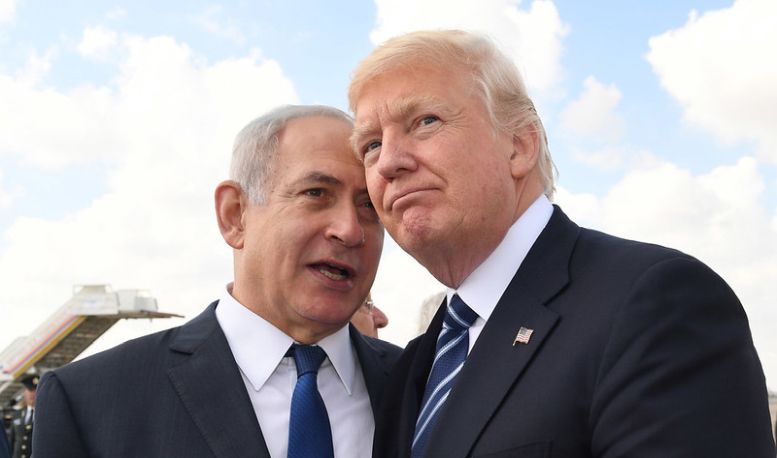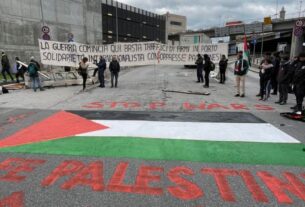A Fragile Ceasefire and Trump
The Middle East continues to be at the centre of world news, with dramatic events and changes at a rapid pace. The main recent changes can be summarized as follows:
- The overall balance of power in the region has changed, underlined by the collapse of the Assad regime in Syria. Israel and Turkey have strengthened their positions, while Iran and its axis have suffered a big defeat, at least for a period.
- The ceasefire deal in Gaza exposes the total destruction of the strip and the huge social and material needs. The fragile deal offers no real peace or solutions.
- With Trump in the White House, the threat against the Palestinian people has drastically increased.
In the last few days, 300,000 Palestinians have returned to north Gaza, most of them walking on the two main roads. Halfway through, at the Netzarim corridor in central Gaza, this mass of people suffering from trauma, malnutrition and diseases had to pass through an airport-style security check run by a US company before arriving in their completely destroyed neighborhoods. There, queues of hundreds lined up for minimal rations of bread and water. North Gaza has no healthcare, electricity or housing. The 600 truckloads of aid per day promised in the peace deal are far from what is needed. The situation will worsen with Israel’s decision to ban UNRWA, the UN organization dealing with Palestinian refugees since 1949. Alongside this, Trump has also blocked further direct aid from the US.
Still, reports speak of a mood of pride at the fact they were able to return at all, not being driven away “for good” as in 1948 or in 1967. However, this feeling of having escaped from a new Nakba was then immediately shaken by Donald Trump demanding the Gaza population to be deported to Jordan and Egypt in a huge ethnic cleansing operation. Trump first raised this last weekend, and has repeated it since, including in phone calls to King Abdullah of Jordan and Egypt’s dictatorial ruler, General al-Sisi.
Trump and Israel
With Trump, it is clear US imperialism is not only a sponsor in the region, but is now attempting to be the director. Trump’s shadow and fist is everywhere. The regimes in Amman and Cairo opposed his demands, but Washington has significant leverage with both states receiving major aid from the US. Both regimes have seen how Trump’s pressure forced Colombia’s president Petro to back down within hours and accept deported migrants with token concessions in return at best. When Trump stopped all foreign aid, the exceptions announced were for Israel and Egypt, with Trump describing al-Sisi as a close friend. Egypt alongside Qatar acted as US proxies in the negotiations for the ceasefire deal.
Mass deportations from Gaza is still not the most likely short-term outcome, but the last word is far from said.
This is underlined by the fact that Trump’s actions and comments received full praise from the Israeli far right leaders, finance minister Smotrich and Ben-Gvir, who resigned as security minister in protest against the ceasefire deal.
The ceasefire was followed by a military offensive by Israel’s army in Jenin on the West Bank. This confirmed that Netanyahu’s government is the most destabilizing factor in the region, continuously using brutal military methods and provocations. Two brigades were sent to attack Jenin two days after the ceasefire deal, using bulldozers, attack jets, drones and ground forces. They attacked the Jenin refugee camp and two hospitals, killing dozens and forcing thousands to evacuate. All roads to Palestinian areas on the occupied West Bank were blocked.
This was done to show that the genocidal war is not over, and possibly also to provoke resistance that would lead to even worse military attacks. The army coordinated with settlers attacking villages, protesting against Palestinian prisoners being released as part of the ceasefire deal. This attack was also what restrained Smotrich from leaving the government. He saw this attack as the beginning of full annexation of the West Bank, at the same time as demanding the war on Gaza to be continued after the first phase of the ceasefire agreement.
All this happened with full support from Trump, who lifted Biden’s sanctions against some extreme-right settlers. The Israeli government also released settlers that were in detention.
Alongside this, Trump also decided to start sending the 1,000 kilo (2,000 pounds) bombs that Biden temporarily blocked.
Trump will be the most supportive US president ever to Netanyahu and the extreme-right. His choice for ambassadors to the UN and Israel both have the same positions as the extreme-right settlers, with Mike Huckabee, the ambassador to Jerusalem claiming there is no Palestinian people.
Ceasefire but no peace, and no plan
The fragile ceasefire started on 19 January, the day before Trump’s inauguration. On that day, 46,913 Palestinians in Gaza had officially been killed since 7 October 2023, with the real number of victims most likely much higher. The first phase, 42 days, has started with exchange of hostages and prisoners, which of course is welcomed by families and the general population, alongside the ceasefire itself. To uphold this phase is therefore in the interest of both Israel’s government and Hamas. But there are no guarantees.
The ceasefire agreement between Israel and Hezbollah in Lebanon was implemented on 27 November. Since then, Israeli forces have conducted more than 1,000 attacks, with 39 villages being destroyed. Residents in south Lebanon report that the real demolition started after the ceasefire, when attacks from drones and the air force were replaced by ground troops. The Israeli army was supposed to withdraw after two months, on 27 January, but the agreement has now been extended to 18 February. There are still one million refugees in Lebanon from the 2024 invasion and bombings.
Basically, everything about Gaza is postponed to phases two and three of the latest ceasefire deal. The deal does not talk about ending the war or say anything about its roots: the occupation, military oppression, siege and settlements or the role of imperialism.
Phase two, with negotiations supposed to begin 4 February, includes a total withdrawal of the Israeli army. However, Netanyahu has already declared that they will not leave the Philadelphi corridor on the border with Egypt, and it is most likely that the Netzarim corridor will be kept by Israel as well. In addition to all of this there is the pressure from the extreme-right to abandon the ceasefire and instead continue the genocidal war. Netanyahu and Trump would of course have no problem blaming Hamas and launching new attacks.
For the moment, however, Trump prefers to portray himself as a “peacemaker.” For Hamas the key issue in phase two is releasing all hostages which means losing their main leverage.
Phase three, which is about rebuilding Gaza and the political future of the strip, is even further away from any solution. Netanyahu’s government maintains its stated war aim to completely eradicate Hamas.
It has also excluded the Palestinian Authority which rules Palestinian areas on the West Bank from any role in Gaza, despite the PA generally acting as a subcontractor to the Israeli state. The PA is largely corrupt and repressive, while Hamas’ popularity has increased with the release of Palestinian prisoners.
Last year, Israel’s parliament also reaffirmed its opposition to a Palestinian state. Generally, Netanyahu has refused to present any plan for Gaza’s future while many of his allies have advocated continued military occupation and new settlements.
The Oslo accords three decades ago already proved the impossibility of establishing a capitalist Palestinian state with any degree of independence. Through military means, the state of Israel kept control of the economy and borders, while massively increasing the settlements on the West Bank. This laid the basis for the Smotrichs and Ben-Gvirs.
Ruling Gaza?
Ideas of Gaza being run by a “technical government” with the support from Egypt, UAE and Morocco, assisted by the PA, have been floated by the Biden administration. These authoritarian Arab regimes are solidly with US imperialism, and thereby with Israel, but they are also under pressure from the masses in their own countries.
Trump’s bet is on a deal with Saudi Arabia. The “Abraham accords” establishing normalised diplomatic and economic links between Israel and UAE and Bahrain were signed under Trump’s first term in 2020, followed by agreements with Morocco and Sudan. For the Saudi regime, such a deal would benefit its economy, military and relationship with the US. Trump has already received a promise from Muhammed bin Salman, Saudi Arabia’s ruler, of investments of 600 billion USD in the US, to which Trump said he hoped for $1 trillion instead. For Gaza, however, “Prince Muhammad is said to have told American interlocutors he fears going the way of Anwar Sadat, the Egyptian leader assassinated after he made peace with Israel,” the Economist reported.
The rulers of UAE and Saudi Arabia have not been siding with Hamas, which has rather received its support from Iran, Qatar and Turkey. Now, after over 15 months of the worst bombardments in history, Hamas still remains the only power in Gaza. It has been severely weakened, with an estimated 18,000 of its fighters killed. But, as outgoing US Secretary of State Anthony Blinken said, they have recruited as many new fighters during the war. It was Hamas troops that escorted hostages to be released as part of the ceasefire deal, their police force is on the streets again, and local authorities with 18,000 employees have attempted to start working.
The genocidal war has not achieved the destruction of Hamas, similar to how the US war and occupation of Afghanistan did not eradicate the Taliban. In Israel, the war has secured the survival of the government, but not in any way security for the population.
US imperialism, Israel’s government and the capitalist Arab regimes all lack plans for Gaza and the Palestinians, apart from continued national oppression and military control.
New regional power balance
This ceasefire deal was already, in every detail, presented at the end of May last year, and agreed by Hamas in July. Since then, there has been a major change in the power balance in the region, based on military gains by Israel.
In September, it inflicted an important defeat on Hezbollah, including killing its leaders. It is estimated that 80% of Hezbollah’s missiles were destroyed. This was against a much more formidable force than Hamas, which had been through the war in 2006 where Israel failed to defeat it, and played a major role in the Syrian civil war. Hezbollah has now been pushed back, losing its control of the Prime Minister and the President of Lebanon.
On 26 October, the first direct exchange of attacks between Iran and Israel escalated with Israel’s army claiming to have destroyed 90% of Iran’s production capacity of ballistic missiles. The attack was regarded as a preparation for an even larger attack on Iran’s nuclear programme.
Then followed Syria, where the regime of Assad, who seemed to have secured its power with the assistance of Russia, Hezbollah and Iran, and restored its relations to other Arab regimes, fell like a house of cards. This broke the supply line from Iran to Hezbollah, cutting Tehran’s “axis of resistance” into pieces. The Israeli army acted immediately, destroying Syria’s air force, naval fleet and storages of weapons. Then Israel advanced on the Golan Heights, which it has occupied since 1967, and into the demilitarised zone, not far from Damascus.
This sequence of events has heavily weakened the Iranian regime, and an awaited new attack on Israel never came. It also weakened Russia in the region and globally.
Israel’s higher standing, weakening the official opposition and creating hubris in its government, assisted in the ceasefire deal materialising. Other important factors were the growing pressure within Israel for a deal, and the election victory of Trump.
Netanyahu wants to be as close as possible to Trump, especially on Iran. Trump has promised “maximum pressure” on Iran (as on most issues), but in the short term he seems to hope the pressure will force Tehran to give in without an armed conflict. Hawks in Israel want an attack on Iran to block it from developing nuclear weapons. But an attack cannot guarantee that result, and could rather encourage the Iranian regime to speed up the process. The regional conflict has pushed Iran closer to Russia and China in the inter imperialist conflict, with a new deal signed with Russia this month.
At a certain stage, the Israeli regime can cross US red lines, knowing it will get support anyway. But in the short-term Netanyahu wants to avoid any problems with Trump, and rather hopes to win his fulsome support for new escalations in the future.
New unstable regime in Syria
It is in this new environment that the HTS regime, which came to power in Syria after the fall of Assad, is trying to balance itself. It is dependent on Turkey, which was the godfather to its power in the Idlib region. The new Damascus government is based on the Idlib ministers. At the same time, it fears upsetting Israel or the US too much. It has introduced parts of its Islamist program, limits on women’s rights, a new curriculum in schools and mosques in the universities, but has not had the power to fully implement it. On economic policy it has launched a big privatisation program, attempting to draw in foreign investments, and prepared to sack more than 100,000 public sector employees.
The so-called Syrian National Army, operated from Turkey, is attacking the Kurdish areas in Northwest, but Turkey has so far held back from an all-out attack. Again, the reason could be that neither the HTS government nor the US want a new war. The US also fears a new growth of Islamic State and needs the Kurdish forces.
Turkey is set to gain, both in regional power and economically, from rebuilding Syria. HTS’s main aim for now is to stay in power, hoping for support from Arab states. On 29 January, its leader Ahmed al-Sharaa formally became President. It talks about elections in four years’ time, probably an estimate on how long it will take to consolidate power.
Role of the working class
The new balance of power in the region does not mean it will not be challenged. For socialists, it is mass movements of the working class and poor masses throughout the region which are decisive to turning the tide.
In Israel, Netanyahu’s military achievements have given him an upper hand versus official opposition parties during the war. But mass protests against his regime have also shown the potential strength from workers and youth. The attack on 7 October resulted in a wave of reactionary propaganda and support from the war. Now the outcome is not what Netanyahu promised.
The movement against the war in the region and globally must continue, demanding the end of the occupation, the siege and oppression — the roots of the horrific war and massacres. This should be linked to a program for democratic and social demands, and organized struggles in workplaces, schools and communities. Workers need fighting trade unions and mass working class political parties to fight in their interests.
The struggle for Palestinian liberation has received mass support internationally, and scared the ruling classes. Solidarity and discussions on what way forward will continue to be central for workers and youth around the world. Comments from people in Gaza include both criticism and praise of Hamas. For most, however, it is clear that the organisation’s reactionary attack on 7 October 2023 did not liberate the Palestinian people, nor have the actions of its allies in Iran or Hezbollah. Lessons must be drawn from the first intifada and grassroots struggles, revolutions and liberation struggles. The defeat of the occupation and solving the national question is linked to a struggle against imperialism and capitalism, and for a revolutionary socialist program.



